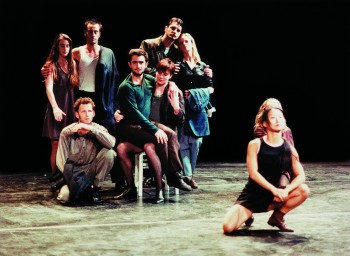Adelaide Festival: What the Body Does Not Remember

What the Body Does Not Remember, essentially the debut work of the choreographer and the company Ultima Vez, established Belgian choreographer Wim Vanderkeybus as a major force when it was first created in 1987.
Twenty six years is a long time in the life span of a company and a work of contemporary dance theatre. Styles develop with speed and new technologies add to the repertoire of available forces, but this is still an exhilarating work which slowly moves from brightness and humour into something darker and more threatening.
Contemporary dance long ago freed itself from the narrative imperative of ballet and works at a level of allusion and ambiguity. The audience can then start to register its own responses to what it sees.
The opening sequence has two male dancers taking up positions prone on the stage. The sound to which they respond is made by a woman at the rear of the stage scraping her fingernails across the surface of a desk, clapping and banging her hands down hard. The two men respond with rolls, jumps, push ups and other demonstrations of core strength. She’s the punishing primary school teacher if you like and the next sequences maintain a child-like love of play.
Dancers appear with large plaster bricks of various sizes which they use as stepping-stones and building bricks. They then start throwing stones across the stage full of running bodies, pushing people out-of-the-way and into safety. There follows a sequence where jackets are swapped, borrowed, stolen again with superb timing, and a similar routine is carried out with brightly coloured beach towels.
In the seeming child-world, violence against a woman dancer starts in a playful fashion and then become intense. Stamping gestures dominate. Then there is a whimsical interlude in which three dancers juggle feathers with their breath, invoking thoughts of King Lear and Hildegard of Bingen’s feather on the breath of God. More stamping characterises a series of assaults in which dancers narrowly avoid been trampled on by their attackers. The nine dancers demonstrated an intensity of engagement and split second co-ordination that was at times breathtaking.
The Festival program timed the work at 65 minutes. As it turned out it was closer to 90 minutes and I wonder if Wim Vanderkeybus approaching the themes now, would possibly bring the work in closer to the predicted as opposed to the actual time.
